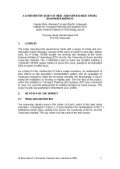-
Past ETC Papers

Browse, search and view papers from the past AET Conferences.
-
Members' Area

AET promotes networking and exchange of ideas, information and opportunities amongst members.
Conference Papers 2008
Noordwijkerhout, Netherlands
ETC Conference Papers 2008
A comparative study of web- and paper-based travel behaviour surveys
Seminar
Day 1 (6 Oct 2008), Survey Methods, Web versus Interviews, 11:00 - 13:00
Status
Accepted, documents submitted
Authors
C Weis, A Frei, K W Axhausen, IVT, ETH Zurich, CH
Short abstract
The paper will deal with the experiences made during the implementation and execution of several surveys of travel behaviour of the members of two Zurich universities. We used the opportunity to test a variety of survey protocols.
Abstract
The paper will deal with the experiences made during the implementation and execution of several surveys of travel behaviour of the members of two Zurich universities. Today around 50?000 people work and study at the institutions based in a central area of the city, i.e. the Swiss Federal Institute of Technology, the University of Zurich, and the University Hospital, which both the major hospital of the canton and as a teaching institution part of the university. As part of he planning process the Municipality of Zurich encouraged an assessment of the impacts of the expected 20% increase in employee and student numbers following the construction of an 150?000 m2 additional gross floor area. The travel behaviour surveys were carried out to support this work. We used the opportunity to test a variety of survey protocols, as the comparative efficiency and selectivity of the different protocols is an under-researched area.
The surveys for the different groups of users in the study area were conducted with different methods over the time period from November 2006 to December 2007. The protocols differed along two main criteria:
- Survey platform: the surveys were conducted via a browser based survey application and by pen-and-paper questionnaires.
- Survey content: some of the surveys were full travel diaries (in different variants), others only recorded the respondents? trips to and from the institution, but for a weekly reporting period.
There is too our knowledge no comparable study, which has tested these factors with the same intensity.
The surveyed included all students and employees of the universities as well as all employees, and samples of the patients and visitors of the University Hospital. The aim was to provide a sample of all traveller categories relevant to the assessment of travel demand to and from the major institutions, as well as enough variability in the population in order to assess the differences in response behaviour based on socio-demographic caracteristics and the different protocols and contents.
The allocation to the different methods resulted on the one hand from the accessibility of the interviewees and their access to the web. Thus, they were mainly due to technical and organisational concern. For example, the e-mail adresses necessary for conducting the online survey were not available for certain groups, forcing the use of pen-and-paper forms for those respondents. On the other hand, the chance of benefiting from an unusually large sample was proactively utilised in order to analyse the influences of the varying survey methods on the response behaviour of the different respondent groups. These differences will be dealt with in the main part of the paper: how do the survey instruments and designs and the related response burdens influence the participation rates and related key figures for the different user groups (number of tours, trips and stages, duration of total travel and activity times). For some subgroups we can test the impact of selected administrative variables on selectivity in their participation.
Difficulties that were experienced during the execution of the surveys will also be discussed. Special weight will be given to the technical problems with the online surveys, their impact on data quality and the continuous attempts at resolving them.
Thus, the scope of the paper will be to explain the differences in response behaviour for the varying survey methods based on assessments of response burden and accounting for the structural differences between the user groups. Data quality issues resulting from the survey designs, such as nonresponse to single items, aborted interviews and incomplete questionnaires, will also be discussed.
A brief description of the main findings of the analysis of the collected data will close the paper. The focus will be on the impacts on the development of the transport system in the perimeter. It will be shown that a large portion of the existing travel demand in the area is indeed generated by the three institutions under examination, and that the expansion could potentially lead to overloads of the transport system. This holds especially for public transport, which accounts for an exceptionally large share of trips to the perimeter.
Documents:

Association For
European Transport
Forester House
Doctors Lane
Henley-in-Arden
Warwickshire, UK
B95 5AW
+44 (0) 15 64 793552
VAT number: 710 1866 64
Conference Supporters & Endorsers




Legal Entity
The Association for European Transport is registered as an Association ('vereniging') with the Chamber of Commerce for Haaglanden in The Netherlands under company number 27170096.
Built on Zenario




